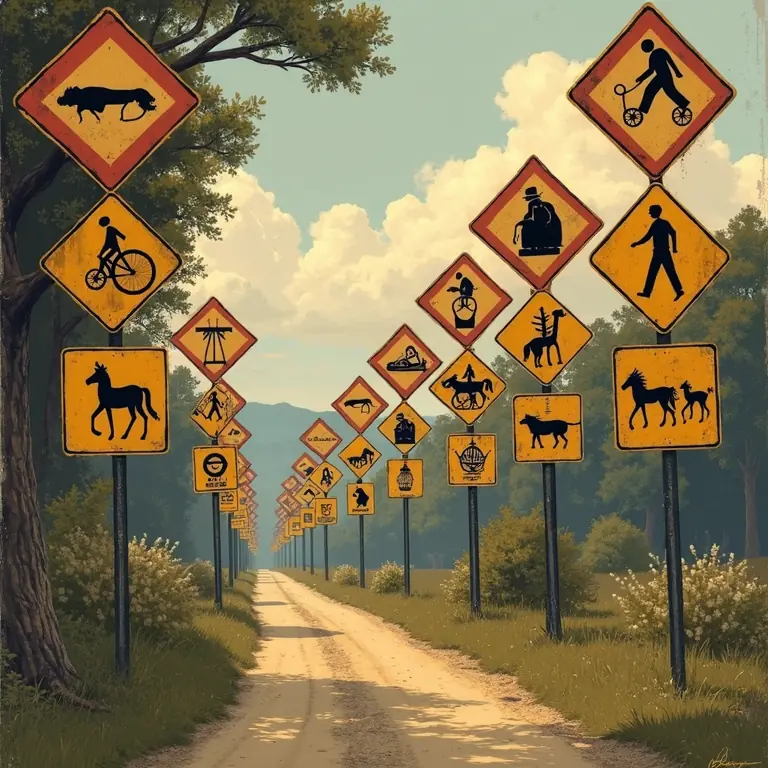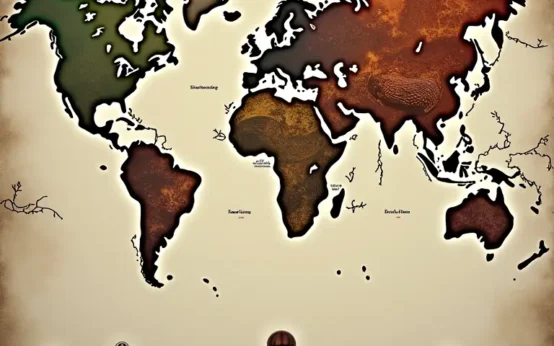For many of us, road signs are simply part of the background noise of travel. We glance at them, absorb the information, and continue on our way. But have you ever stopped to consider the history behind these ubiquitous markers? The evolution of road signs isn’t a chaotic jumble of ad-hoc decisions. Instead, it reveals a surprisingly consistent logic, rooted in human psychology, practical needs, and even a desire for aesthetic harmony. From the earliest milestones to the standardized systems we know today, the story of road signs is a fascinating journey through time, reflecting the changing priorities and technologies of societies across the globe.
The Precursors to Signs: Landmarks and Milestones
Before the invention of written language, travelers relied on natural landmarks – prominent hills, distinctive trees, unique rock formations – as navigational aids. These features served as recognizable points of reference, memorized and passed down through generations. As civilizations developed, the need for more formal markers arose. The earliest form of what we’d recognize as a road sign wasn’t a sign at all, but a milestone.
Milestones, dating back to the Roman Empire, were initially used for measuring distances. The Romans were renowned for their extensive road network, and milestones, often made of stone (hence the name!), were placed at regular intervals – typically, one Roman mile (approximately 1,480 meters). These milestones not only indicated distance from key cities but also served as declarations of Roman authority and engineering prowess. They were often inscribed with the name of the emperor under whose reign the road was built or repaired, and the distance to the nearest significant settlement. The precision and organization involved in creating and maintaining these milestones highlight the Roman commitment to efficient administration and communication.
Beyond Rome, similar systems emerged independently in other parts of the world. In China, during the Han Dynasty (206 BC – 220 AD), milestones and boundary markers were used to delineate administrative regions and facilitate trade. These markers were often made of stone or brick and inscribed with information about the location and its administrative status. The Inca Empire, despite lacking a written language, developed an impressive network of roads (the Qhapaq Ñan) and used a system of stone piles and markers to indicate direction and distance. These markers, though not inscribed, were clearly understood by travelers and served a vital navigational purpose.
Medieval Markers: Religious Symbols and Local Customs
With the decline of centralized empires like Rome, road maintenance and signage often fell into disrepair. The Middle Ages saw a fragmentation of authority, and road systems suffered accordingly. However, the need for guidance didn’t disappear. Instead, new forms of markers emerged, often reflecting the dominant religious and cultural influences of the time.
In Europe, many roads were named after the saints to whom they were dedicated, and religious symbols became common markers. Crosses, statues of saints, and shrines were erected along roadways, serving both a devotional purpose and a navigational one. These markers weren’t standardized; their placement and design were often determined by local customs and the preferences of the communities they served. For example, in many parts of Europe, trees were planted along roadsides to provide shade and serve as landmarks. These trees were sometimes deliberately shaped or marked to indicate direction or the proximity of a village.
The practice of painting symbols on buildings to indicate the trades practiced within – a boot for a shoemaker, a comb for a barber – also indirectly contributed to a form of roadside information. While not explicitly designed as road signs, these markings helped travelers locate essential services. The concept of using visual cues to convey information was becoming increasingly refined, laying the groundwork for more formal signage systems.
The Rise of Pictorial Signs: 17th and 18th Centuries
The 17th and 18th centuries witnessed a growing interest in mapmaking and accurate representation of the landscape. This, coupled with the increasing volume of travel, spurred the development of more sophisticated road signage. The first truly recognizable road signs – those using pictorial symbols to convey information – began to appear, primarily in France and England.

In 1737, John Ogilby’s Britannia, a comprehensive road atlas of England and Wales, included detailed descriptions of routes and landmarks. While not providing roadside signs themselves, Ogilby’s atlas encouraged the use of painted signs to mark distances and directions. These early signs were often simple, hand-painted wooden boards with rudimentary images indicating the direction to nearby towns. The challenge lay in creating symbols that were universally understood, a problem that would continue to plague sign designers for centuries.
France, under the direction of the royal engineer Jean-Baptiste Colbert, began a program of road improvement and signage in the late 17th century. Colbert ordered the construction of stone markers, known as bornes, along major routes. These bornes were inscribed with the name of the road, the distance to Paris, and often a royal emblem. They were a clear demonstration of state control over infrastructure and a deliberate attempt to improve travel conditions. This period also saw the emergence of more elaborate pictorial signs, depicting landmarks or local features to aid navigation. The evolution of these early pictorial signs can be seen as a precursor to the internationally recognized symbols we use today. Consider, for instance, the enduring symbolism found in knots across cultures – a testament to how images can transcend language barriers. Explore the rich history of knot symbolism.
The 19th Century: Standardization Begins
The 19th century, with the advent of the Industrial Revolution and the rise of mass transportation, brought about a dramatic increase in road traffic. The need for standardized signage became increasingly urgent. Prior to this, variations in sign design and placement were common, leading to confusion and potential accidents.
Great Britain took a leading role in the movement towards standardization. In 1836, the British Parliament passed the Roads Act, which authorized the appointment of surveyors to mark roads with numbered milestones. This was a significant step towards a national system of road identification. However, the symbols used on signs remained largely unregulated, leading to a patchwork of local variations.
In the United States, the development of road signage was initially hampered by a lack of centralized authority. Each state and even individual counties were responsible for maintaining their own roads and signage. As a result, a bewildering array of signs, often inconsistent in design and meaning, proliferated across the country. The rise of the automobile in the early 20th century would eventually force a reassessment of this fragmented system.
The 20th and 21st Centuries: Modern Systems and Global Harmonization
The widespread adoption of the automobile in the early 20th century created an unprecedented demand for clear, consistent, and standardized road signage. The United States, initially lagging behind Europe in this regard, began to address the issue in the 1920s. The American Association of State Highway Departments (AASHTO) played a crucial role in developing a national system of route numbering and sign design.
The U.S. numbered highway system, established in 1926, assigned unique numbers to major routes, allowing drivers to navigate across state lines with relative ease. This was accompanied by a standardized set of signs, featuring bold, easily readable fonts and simple, universally recognized symbols. The emphasis shifted from relying on intricate pictorial representations to using clear, concise graphics that could be understood at a glance. You can see the engineering marvels that paved the way for this system in this video:

Europe followed a similar path, with various countries adopting standardized sign systems throughout the 20th century. The Vienna Convention on Road Signs and Signals, adopted in 1968, aimed to harmonize road signage across Europe and beyond. This convention established a common set of symbols and design principles, promoting greater consistency and safety for international travelers. The principles of geometry and design, inherent in these sign systems, echo the precision found in other ancient practices, such as the construction of buildings. Discover the mathematical principles behind ancient architecture.
Today, road sign systems around the world continue to evolve, incorporating new technologies and addressing emerging challenges. Reflective materials, variable message signs, and intelligent transportation systems are all contributing to safer and more efficient roadways. However, the fundamental principles underlying road signage – clarity, consistency, and universal understandability – remain as important as ever. The subtle art of calligraphy, with its emphasis on legibility and form, also provides insight into the design considerations behind effective signage. Explore the history and artistry of calligraphy.
The Psychology of Road Signs: How We Perceive and React
The effectiveness of road signs isn’t solely dependent on their physical design. Psychological factors play a crucial role in how drivers perceive and react to signage. Research in human factors and cognitive psychology has revealed that drivers typically have limited time to process information while driving. Therefore, signs must be concise, easily readable, and strategically placed to maximize their impact.
Color plays a vital role in conveying information. Red is typically used to indicate prohibitions or warnings, yellow to signal caution, and green to denote directions or destinations. The use of standardized colors helps drivers quickly and instinctively interpret the meaning of a sign. Shape also matters. Octagonal signs are universally recognized as stop signs, while triangular signs typically indicate warnings.
The size and placement of signs are also carefully considered. Signs must be large enough to be seen from a distance, but not so large as to be distracting. They should be placed in locations where they are easily visible and where drivers have sufficient time to react to the information they convey. The careful consideration of these psychological factors demonstrates that road sign design is not merely a technical exercise but a sophisticated application of behavioral science.
Looking Ahead: The Future of Road Signage
As autonomous vehicles become increasingly prevalent, the role of road signs is likely to evolve. While traditional signs will continue to be important for human drivers, autonomous vehicles will rely more heavily on digital maps and sensor data. However, even in a future dominated by self-driving cars, road signs will likely remain a vital component of the transportation infrastructure, providing a redundant layer of information and ensuring safety.
The development of dynamic signage systems, which can adjust their messages based on real-time traffic conditions, is another promising trend. These systems can provide drivers with up-to-date information about congestion, accidents, and other hazards, helping them make informed decisions about their routes. Furthermore, the integration of augmented reality (AR) technology could enhance the visibility and usefulness of road signs, projecting information directly onto the driver’s windshield. The intricate structures created by bird nests, demonstrating natural engineering principles, offer inspiration for efficient and resilient design. Learn about the geometry of bird nests.
Ultimately, the story of road signs is a testament to human ingenuity and our enduring need to navigate and connect with the world around us. From the humble milestones of ancient Rome to the sophisticated systems of today, road signs have played a crucial role in facilitating trade, promoting communication, and ensuring safe travel. The consistency of their logic, spanning millennia and cultures, reveals a fundamental human desire for order, clarity, and a shared understanding of the spaces we inhabit. The precision and artistry found in shadow puppetry, another ancient art form, demonstrate a similar commitment to conveying complex narratives through visual cues. Discover the history of shadow puppetry.


 The Curious Acoustics of Historical Echo Chambers: Resonance, Ritual, and Revelation
The Curious Acoustics of Historical Echo Chambers: Resonance, Ritual, and Revelation  The Curious Cartography of Scent: Mapping Perfume Ingredients Through History
The Curious Cartography of Scent: Mapping Perfume Ingredients Through History  The Curious Lexicon of Lost Trades
The Curious Lexicon of Lost Trades  The Surprisingly Consistent Science of Historical Ice Harvesting – A Frozen History of Commerce & Preservation
The Surprisingly Consistent Science of Historical Ice Harvesting – A Frozen History of Commerce & Preservation  The Unexpectedly Consistent Science of Historical Buttonhooks – Fashion, Function & Forgotten Tools
The Unexpectedly Consistent Science of Historical Buttonhooks – Fashion, Function & Forgotten Tools  The Surprisingly Consistent Science of Historical Toy Soldiers – Miniature Warfare, Materials & Collective Play
The Surprisingly Consistent Science of Historical Toy Soldiers – Miniature Warfare, Materials & Collective Play